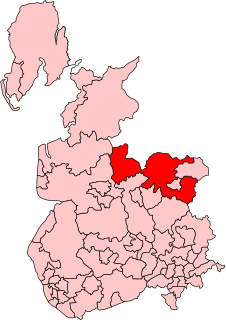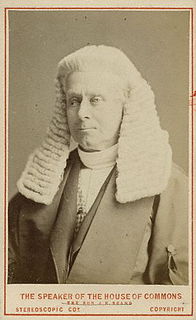
Plymouth, Devonport was, from 1832 until 2010, a borough constituency represented in the House of Commons of the Parliament of the United Kingdom. It covered part of the city of Plymouth in South West England, including the former borough of Devonport.

Canterbury is a constituency represented in the House of Commons of the UK Parliament since 2017 by Rosie Duffield of the Labour Party.
Mayo was a parliamentary constituency in Ireland, which returned two Members of Parliament (MPs) to the House of Commons of the Parliament of the United Kingdom from 1801 to 1885.
Derby is a former United Kingdom Parliamentary constituency. It was a constituency of the House of Commons of the Parliament of England, then of the Parliament of Great Britain from 1707 to 1800 and of the Parliament of the United Kingdom from 1801 to 1950. It was represented by two members of parliament. It was divided into the single-member constituencies of Derby North and Derby South in 1950.
Bridgnorth was a parliamentary borough in Shropshire which was represented in the House of Commons of England from 1295 until 1707, then in the House of Commons of Great Britain until 1800, and in the House of Commons of the Parliament of the United Kingdom from 1801 until its abolition in 1885.
Walsall was a borough constituency centred on the town of Walsall in the West Midlands of England. It returned one Member of Parliament (MP) to the House of Commons of the Parliament of the United Kingdom, elected by the first past the post voting system.
Northampton was a parliamentary constituency, which existed until 1974.

Clitheroe was a parliamentary constituency in Lancashire.
Rochester was a parliamentary constituency in Kent. It returned two members of parliament (MPs) to the House of Commons of England from 1295 to 1707, then to the House of Commons of Great Britain from 1708 to 1800, and finally to the House of Commons of the Parliament of the United Kingdom from 1801 until the 1885 general election, when its representation was reduced to one seat.
Rye was a parliamentary constituency centred on the town of Rye in East Sussex. It returned two Members of Parliament to the House of Commons of the Parliament of the United Kingdom until its representation was halved under the Reform Act 1832.
Barnstaple was a parliamentary constituency centred on the town of Barnstaple in Devon, in the South West of England. It returned two Members of Parliament to the House of Commons of the Parliament of the United Kingdom until 1885, when its representation was reduced to a single member.
Southampton was a parliamentary constituency which was represented in the British House of Commons. Centred on the town of Southampton, it returned two members of parliament (MPs) from 1295 until it was abolished for the 1950 general election.
Cricklade was a parliamentary constituency named after the town of Cricklade in Wiltshire.
Norwich was a borough constituency which was represented in the House of Commons of England from 1298 to 1707, in the House of Commons of Great Britain from 1707 to 1800, and in the House of Commons of the United Kingdom from 1801 until it was abolished for the 1950 general election. Consisting of the city of Norwich in Norfolk, it returned two members of parliament (MPs), elected by the bloc vote system.

Coventry was a borough constituency which was represented in the House of Commons of England and its successors, the House of Commons of Great Britain and the House of Commons of the United Kingdom.
Boston was a parliamentary borough in Lincolnshire, which elected two Members of Parliament (MPs) to the House of Commons from 1547 until 1885, and then one member from 1885 until 1918, when the constituency was abolished.
Leicester was a parliamentary borough in Leicestershire, which elected two members of parliament (MPs) to the House of Commons from 1295 until 1918, when it was split into three single-member divisions.
Nottingham was a parliamentary borough in Nottinghamshire, which elected two Members of Parliament (MPs) to the House of Commons from 1295. In 1885 the constituency was abolished and the city of Nottingham divided into three single-member constituencies.
The Stroud by-election of May was fought on 15 May 1874. Caused by the election of Liberal MP, Sebastian Stewart Dickinson being declared void on petition on "account of treating, but the treating was not with knowledge of the candidates".. It was retained by the Liberals.







